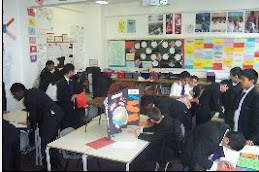Time is ridiculoulsy important to me. I love watches, and clocks, and I like being on-time. My students do not, they like to be late. They look at me like I am from another planet if I make a fuss about lateness. Yet I persist, because being on-time is both an important life skill and crucial for using learning time wisely.
Having a positive meaningful start to lessons encourages students to be there from the beginning. Being at the door and out in the corridor (if necessary) also encourages everyone inside. But although setting up a good classroom atmosphere will entice most students in punctually what can I do if students are not on time?
I use a lateness chart pinned to my wall to deal with this matter. Students know that if they need to enter after the classroom door has shut (the door is my signal for 'we are working now') then they must knock. When it is appropriate and they can enter they must 'sign-in' on the lateness log. Doing so serves two purposes; firstly it means that if I have taken the online register and the fire bell goes then I have a record of who is additionally in class to the web-register and, secondly, it means I can remember at the end of the lesson who I need to speak to.
This process works for students because it is quick, consistent and it doesn't mean that I am asking questions in front of everyone as students sometimes are embarrassed about the reasons they are late. There's very little argument about signing up as students know if they have a good reason then they can explain at the end (there are no automatic sanctions in my room for lateness). Also, it means students move straight to learning after the writing. This is my main goal, if they have already wasted time then I don't want them to waste anymore.
This year I had an additional complication to the system because I didn't have a classroom, so I invented 'clock-in' cards that work on the same principle but I hand them to the student when entering the classroom. It's slightly harder to keep track of (I'm partial to losing clock-in sheets under papers on the desk) but it's almost as good as the sign-up sheet.
At the end of the lesson I speak to students and decide on an appropriate consequence depending on their reason - maybe time off break, additional work or something else. I also make it clear that if the lateness persists (and I can check regularity as I keep completed lists in a file) there will be more serious consequences along my warning scale (which I will explain shortly!).
8 months ago
